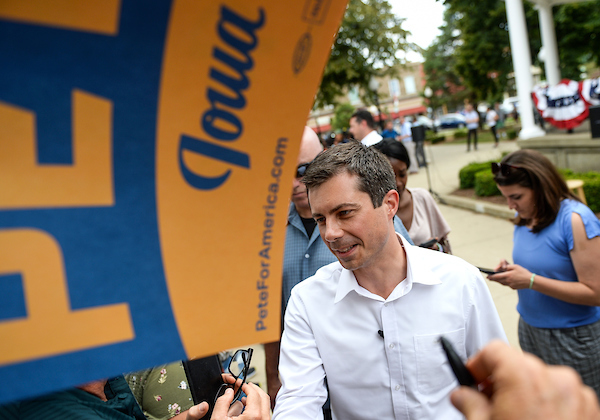So much Iowa, so little time
Snapshots of a state that will be a big deal politically for a while

DES MOINES, Iowa — It is difficult for some people to accept that Iowa, a relatively small state in the middle of the country, has such an outsize role in determining the next president. But the Hawkeye State is more of a microcosm of U.S. politics and the country than it might first appear.
Iowa’s population of roughly 3 million people is tiny compared to mega-states like California, Texas and Florida, and it has a lack of racial diversity (it is about 87 percent white, according to the U.S. Census Bureau). But its voting patterns and political infrastructure make it a valuable barometer.
Yes, for the presidency, Republican Donald Trump beat Hillary Clinton in 2016, 51 percent to 42 percent. But Democrat Barack Obama beat Republican Mitt Romney 52-46 percent in 2012 and Obama beat Republican John McCain in 2008, 54-44 percent. That came after Republican George W. Bush beat Democrat John Kerry in 2004, 50-49 percent. Who wouldn’t want to study those elections to find out what happened and why Iowa voters changed from election to election?
And then there are the congressional races.
Republican Sen. Charles E. Grassley is a juggernaut in the state, easily winning election after election. At 85 years old, he shows no signs of slowing down. What is the one thing that people most commonly say they know about Grassley? It’s that he visits each one of Iowa’s 99 counties every year. Rural. Suburban. Urban. Republican. Democratic. River. Prairie. “The Full Grassley” it’s called.
Republican Sen. Joni Ernst, who beat Democrat Bruce Braley 52-44 percent in 2014 and is up for reelection this cycle, is following suit. As is Democrat John Delaney, a former congressman from Maryland now running for president. There seems to be a lesson there, that the first thing on the to-do list for a politician might be to show up and listen.
At the House level, an independent redistricting commission draws the lines after each census, with an eye to keeping communities intact and respecting traditional boundaries. Each election cycle, three of the four seats are typically competitive, and in 2020 all four are, potentially.
Much is made of the fact that Iowa is overwhelmingly rural. But on a scale, its population is clustered in similar patterns to other bigger and more diverse states. Its large cities — Cedar Rapids, Davenport, Des Moines, Council Bluffs, Dubuque — are population centers with less-dense suburbs that have malls and highways that eventually give way to farmland. On a much bigger scale, that pattern repeats in California, Texas, Florida, New York, Illinois, Pennsylvania, Ohio and on.
And while Iowa is not the most diverse place, its politics certainly are. Before Ernst was elected, her seat was held for decades by the very liberal Democrat Tom Harkin. Iowans did not see a problem with having one of the more conservative senators, Grassley, paired with one of the more progressive, Harkin, for years.
We saw a lot of this play out in Iowa in our week-plus at the Iowa State Fair here.
- ‘Embrace it and take it all in’: Former Rep. David Young on the Iowa State Fair
- Former Iowa governor: Take rural voters seriously
- Watch: Steve King calls principles ‘timeless’
- Candidates, calories and cows: What really happens at the Iowa State Fair
We went into several other parts of the state as well, be they Clear Lake, Oskaloosa, Fairfield, Muscatine, Wheatland, Greenfield. We put it all together for several podcasts, stories, videos and photo essays.
- Democrats go on defense in crucial heartland House race in Iowa
- Tom Harkin makes rare appearance with 2020 contender
- Loebsack backed Obama over Clinton in 2007, but unsure about 2020 field
- Photos from the Iowa Wing Ding
We hope it gives you a few snapshots of what we learned and observed here.
- Iowa Culture Shock: Moving to the Midwest to staff a presidential campaign
- See the Iowa Caucuses early on Aug. 30!
Like it or not, Iowa will continue to be a big deal politically, at least for the foreseeable future. Might as well look at the reasons why.





